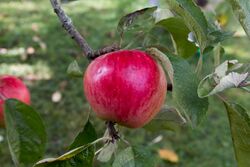Biology:Akane (apple)
| Malus pumila 'Akane' | |
|---|---|
 | |
| Species | Malus pumila |
| Hybrid parentage | 'Jonathan' × 'Worcester Pearmain' |
| Cultivar | 'Akane' |
| Origin | |
'Akane', also known as 'Tokyo Rose', 'Tohoku No.3' and 'Prime Red',[2] is a Japanese cultivar of domesticated apple, that according to Orange Pippin is one of the best early season apples.[3]
'Akane' was developed by the Morika Experimental Station of Japan sometime between 1900 and 1949,[4] by crossing a Jonathan apple with a Worcester Pearmain,[3][5] and was introduced to the United States in 1937, where it is very popular.[3][6]
Description
'Akane' is of moderately good disease resistance, best at warm climates but tolerates cold also. It flowers mid-late season, and should be harvested early-mid season. It is self-sterile and needs to be cross pollinated.
It produces heavy crop of variable sized fruits,[3] usually more to the smaller side,[5] but good sized apples can be obtained by thinning.[7]
'Akane' carries the fruit shape of the English 'Worcester Pearmain', and the unusually good balanced flavor of the 'Jonathan'.[8] Shape ranges from flattened to heart-shaped.[5] Fruits have a very good flavor, a blend of sweet and sharp, preferable for eating, keeps shape in cooking. Flesh color is white,[3] with a yellow tinge. The flesh does not oxidize quickly. The apple is crisp, but not too dense; it is easy to eat.[5] Skin color is red. The fruit keeps fresh for about one week.[3][unreliable source?]
References
- ↑ See text and references.
- ↑ National Fruit Collection, http://www.nationalfruitcollection.org.uk/full2.php?id=84&&fruit=apple, retrieved 18 December 2015
- ↑ 3.0 3.1 3.2 3.3 3.4 3.5 Akane at Orange Pippin.
- ↑ Fruit Gardener says 1930, Trees of Antiquity says 1937.
- ↑ 5.0 5.1 5.2 5.3 Fruit Gardener
- ↑ Fruit Gardener says, not as popular as Orange Pippin implies.
- ↑ Trees of Antiquity
- ↑ Akane tree by Orange Pippin Trees.
 |




